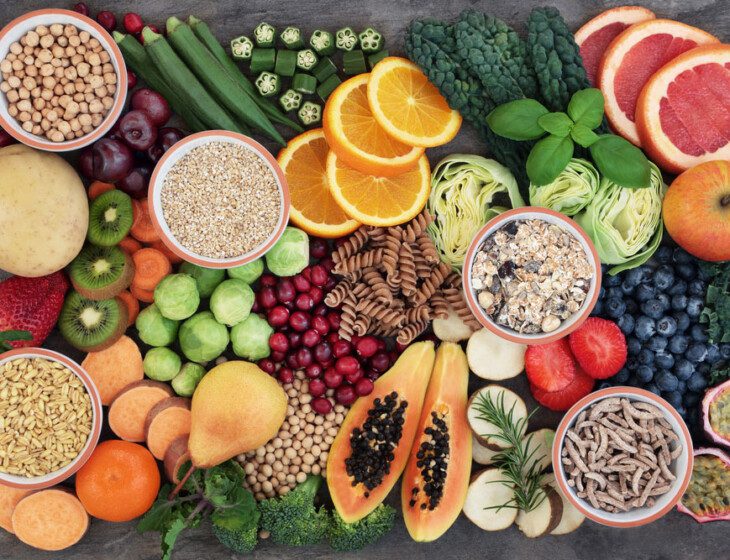If you’re daunted by all the health concerns that come with advancing age, you may be delighted to learn that you can influence your future health from the comfort of your own kitchen.
Good nutrition plays an increasingly important role in your overall well-being as you age. That makes it important to pay close attention to not just how much you eat, but also what kinds of foods you’re using to nourish your body.
Start making better-informed food choices for better health with these tips for senior nutrition.
Talk with your doctor.
Before making any significant changes to your diet, it’s a good idea to talk with your doctor about your specific health concerns. A professional can help answer questions based on your unique calorie needs and medical history. A doctor can also refer you to a nutritionist who can tailor an eating plan based on your nutrition requirements, the healthy foods you enjoy eating and your lifestyle.
Be conscious of calories.
As you age, your metabolism slows down and you’re likely to be less physically active than in your younger years. Calories are what your body burns to give you energy, but if you take in more calories that you burn for energy, those excess calories get stored in the body as fat. On the other hand, if you don’t get enough calories, you might feel sluggish and low on energy. Balancing your calories and physical activity is important for maintaining a healthy weight.
The Dietary Guidelines for Americans updated in 2020 contain numerous tips for senior nutrition, including suggested daily calorie needs. An average woman over 65 with a sedentary level of activity (little exercise beyond daily living) should aim for about 1,600 calories a day; the average for men is slightly higher at 2,000 calories. However, that number could go up or down depending on your level of activity and other health factors.
Plan your plate around key nutrients.
In the past, you may have heard about the food pyramid. More recently, the U.S. Department of Agriculture created MyPlate as an easy visual guide to help you see how a healthy diet looks. When your plate is colorful, like a rainbow, you’re more likely to consume a balanced variety of vitamins and minerals.
Half of your plate should be fruits or vegetables. Brightly colored fruits and vegetables, including leafy greens, are low-fat, low-sodium, and often low-calorie options that deliver important nutrients like potassium, dietary fiber, Vitamin C and folate.
The rest of the plate should include a moderate serving of lean protein (like lean cuts of meat, seafood, eggs and beans) and grains, half of which should be fiber-rich whole grains for good digestive health. For most people, dairy foods are a major source of calcium, which is important for protecting your bone strength as you age. Plan on three cups of low-fat or fat-free dairy products each day to get the health benefits of dairy’s essential vitamins and nutrients without the added fat.
Eat smaller meals more often.
Many older adults report feeling full fast or having smaller appetites than in the past, often as a result of a slowing digestive system. If this is a problem for you, one senior nutrition tip is to spread your meals out over the day, instead of trying to fit everything into three larger sittings. You might add a morning and afternoon snack, or simply add another meal or two to the traditional three meals a day.
Keep a drink handy.
Water is to the body what oil is to a car. It helps keep all your body systems in good working order, and it keeps your skin more supple and less prone to injury. However, too much fluid intake can interfere with your appetite, so it’s a good health habit to sip on drinks you enjoy throughout the day. Just take care to avoid beverages with added sugars or excess sodium.
Pay attention to foods that upset your system.
Some senior nutrition tips involve the foods you should avoid more than what you should be eating.
For example, too much salt can lead to dehydration and higher blood pressure. You may also start to notice certain foods affecting your body in unpleasant ways, like causing indigestion, nausea, gas, bloating or constipation. Not only uncomfortable, this can also prevent you from getting the nutrients you need. If you notice symptoms on a regular basis, pay attention to what you’re eating to identify the culprit.

Reinvent your favorite foods.
You may be surprised how easy it is to swap a few ingredients and keep enjoying your favorite foods. For example, chicken tacos are a leaner choice than beef, and whole grain pasta offers greater health benefits than regular pasta. With age, your senses also begin to fade, so you can pump up the flavor with extra seasonings like spices and herbs.
Make eating healthy more convenient.
Packaged foods can make it easier to ensure you’re getting proper nourishment on a regular basis. You’ll need to watch the salt content, especially if you have heart disease or high blood pressure concerns, but taking shortcuts can make a big difference. For example, frozen veggies are generally already trimmed and ready to heat and eat. You can also get fresh produce off the salad bar at the grocery store that is already cleaned and prepped for eating.
Another tip for senior nutrition is to spend some time once a week preparing healthy meals you can enjoy in smaller portions for several days. If you invite a family member to help, you can get the added benefit of sharing favorite recipes with another generation.
Consider a lifestyle change.
If you’re wary of the work it takes to maintain a nutritious menu, you may be ready to consider a lifestyle change. One advantage of living in a retirement community is access to flexible dining services that ensure you can enjoy nutritious meals every day, without worrying about the preparation work or grocery shopping.
At Querencia at Barton Creek in Austin, the culinary team prioritizes senior health and nutrition, using only the freshest ingredients to create artful and diverse options infused with local flavor. You can find elegant dinner options in the Mesquite Dining Room, grab a casual bite in the Limestone Grill or even entertain guests over a meal in the private dining room.
The focus on wellness extends beyond mealtime as well, with health care resources and ample opportunities for residents to nurture their intellectual, physical, social and spiritual well-being.
If you’re ready to dig in and begin exploring how delicious life at Querencia can be, fill out the form below to request an introduction.


